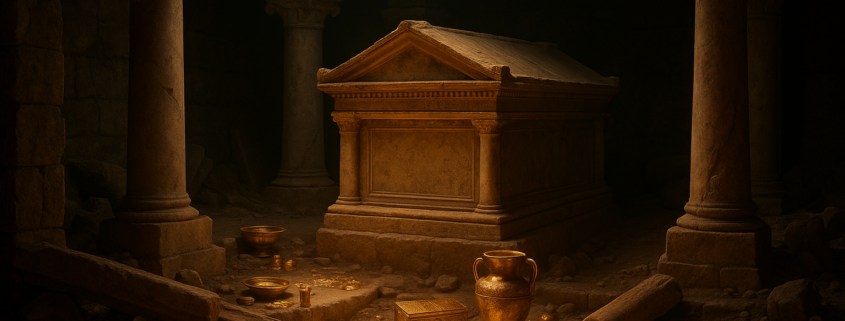Alexander the great lost tomb mystery
Alexander the great lost tomb (The Enduring Mystery): History, Theories, and the Ongoing Search
The final resting place of Alexander the Great remains one of history’s most captivating mysteries—an enigma that has intrigued historians, archaeologists, and adventurers for over two millennia.
The Death of a Legend
Alexander the Great, the famed Macedonian conqueror, died in June 323 BCE in the palace of Nebuchadnezzar II in Babylon. His untimely death, at just 32 years old, sparked immediate speculation. While some ancient sources attributed it to fever or typhoid, modern scholars have proposed various theories—including the possibility of Guillain-Barré syndrome. Regardless of the cause, his death marked the beginning of a legendary tale surrounding his burial.
The Journey of His Remains
Historical accounts agree that Alexander’s body was embalmed—perhaps using honey or early Egyptian mummification techniques—and placed in an extravagant gold sarcophagus. Initially, his remains were destined to return to Macedonia for burial. However, Ptolemy I, one of his generals and the eventual founder of Egypt’s Ptolemaic dynasty, hijacked the funerary procession in Syria and brought the body to Egypt.
Alexander was first interred in Memphis, Egypt’s traditional capital, before being moved to the newly established city of Alexandria. There, he was buried in a grand mausoleum known as the(Soma) or (Sema), becoming a centerpiece of reverence and pilgrimage.
A Tomb Lost to Time
For centuries, Alexander’s tomb attracted the world’s most powerful figures. Roman emperors such as Julius Caesar, Augustus, and Caligula reportedly visited his resting place, some leaving offerings or even taking relics. But by the 4th or 5th century CE, amid the decline of the Roman Empire and the rise of Christianity, the tomb’s location faded from memory.
Despite numerous historical references and traveler accounts during the medieval period, including those from Leo Africanus and George Sandys, no verifiable trace of the tomb remains today.
Competing Theories and Proposed Locations
Over 140 official attempts have been made to locate Alexander’s tomb, most of them focusing on Alexandria. One prominent theory suggests the tomb lies beneath the modern-day Nabi Daniel Mosque, where 19th-century excavations raised hopes—but yielded no conclusive proof.
Another controversial claim came in 1995 when Greek archaeologist Liana Souvaltzi announced she had discovered Alexander’s tomb in Egypt’s remote Siwa Oasis. Although initially celebrated, her findings were later met with skepticism and eventually dismissed by Egyptian authorities and academics.
Some scholars argue that to protect the tomb from desecration, Ptolemaic officials may have secretly relocated it to Egypt’s Eastern Desert. Meanwhile, in northern Greece, the discovery of the massive Kasta Tomb at Amphipolis in 2014 raised speculation that it could be linked to Alexander or his close circle. However, subsequent studies indicated that the tomb likely belonged to Hephaestion, Alexander’s close companion, or other members of the royal court.
Modern Excavations and Scientific Efforts
In recent years, a new wave of excavations has reignited interest in the tomb’s location. In 2023, Greek archaeologist Dr. Calliope Limneos-Papakosta began extensive digs in Alexandria’s Shallalat Gardens—an area believed to overlap with the ancient royal quarter. Her team uncovered a marble statue resembling Alexander and continues to explore underground structures possibly linked to the lost mausoleum.
Dr. Limneos-Papakosta theorizes that the tomb may lie intentionally buried beneath modern Alexandria, obscured by centuries of urban development. However, critics argue that changes in the landscape—especially rising sea levels—may have permanently submerged or eroded key areas.
Intriguingly, fragments of what may have been Alexander’s sarcophagus have surfaced in an unlikely location: St. Mark’s Basilica in Venice. While unconfirmed, this theory adds another layer to the puzzle, suggesting a possible medieval relocation of relics.
Theories Continue to Multiply
As of 2024, researchers like Egyptologist Christian de Vartavan propose that Alexander’s tomb could lie deep within Egypt’s Eastern Desert, far from any previously considered location. Meanwhile, recent forensic studies in Vergina (ancient Aigai, in modern Greece) confirmed that the tombs housed the remains of Philip II (Alexander’s father), Alexander IV (his son), and other family members—but not Alexander himself.
The once-bold hypothesis that Alexander was buried in Vergina, proposed by Byzantinist Eleni Glykatzi-Arveler, has largely been dismissed based on archaeological evidence.
The Quest That Never Ends
From the ruins of Alexandria to the deserts of Egypt and the tombs of Amphipolis and Venice, the search for Alexander the Great’s tomb spans continents and centuries. Modern technology—like ground-penetrating radar and satellite imaging—is now being employed to uncover what ancient maps and historical texts have failed to reveal.
Each new excavation brings renewed hope—and renewed debate. Some believe the tomb is lost forever to history, while others remain convinced that a breakthrough is just around the corner.
Why It Matters
Uncovering Alexander’s tomb would be more than an archaeological triumph. It would represent the rediscovery of one of history’s most influential figures—shedding light on ancient funerary practices, Hellenistic politics, and the legend that has surrounded him for over 2,000 years.
Until then, Alexander the Great’s tomb remains a symbol of historical mystery, drawing scholars and dreamers alike toward its elusive presence. Hidden beneath sand or stone, it waits—silent, majestic, and still unfound.
Discover Unsolved Archaeological Mysteries with Axatours
Get ready for the ultimate Egyptian adventure! With Axatours, we take you on exclusive, expertly curated tours designed to immerse you in the heart of Egypt’s rich culture and history. Our experienced team will guide you every step of the way, ensuring an unforgettable journey. For more details and exclusive offers, click the link here and start planning your dream trip!
Written by ATW August 2025.





